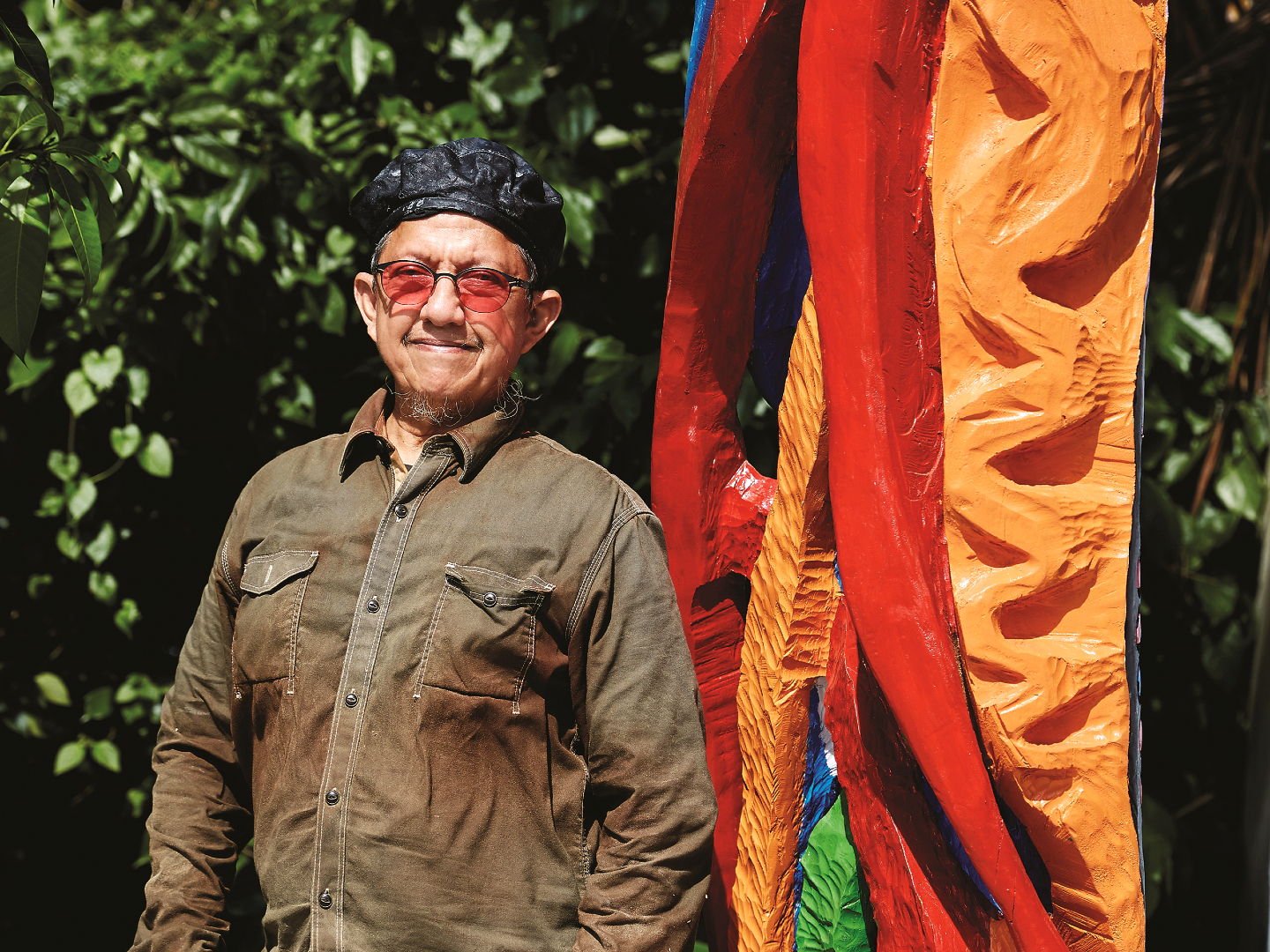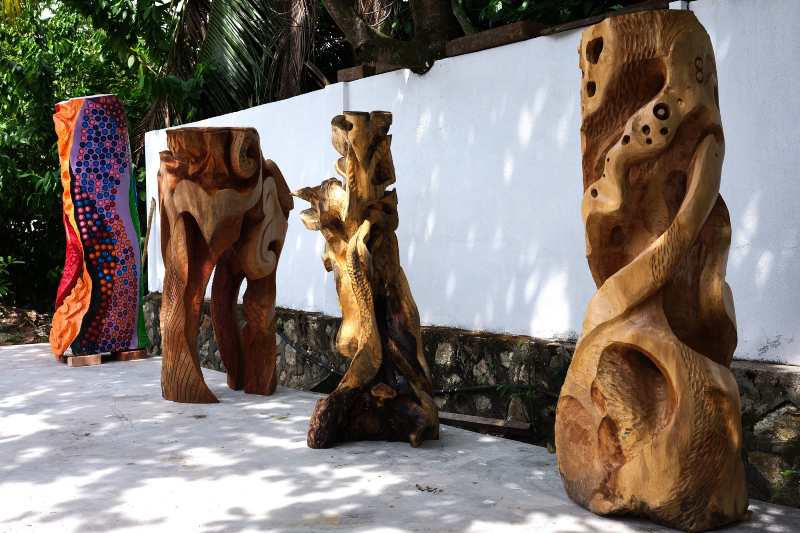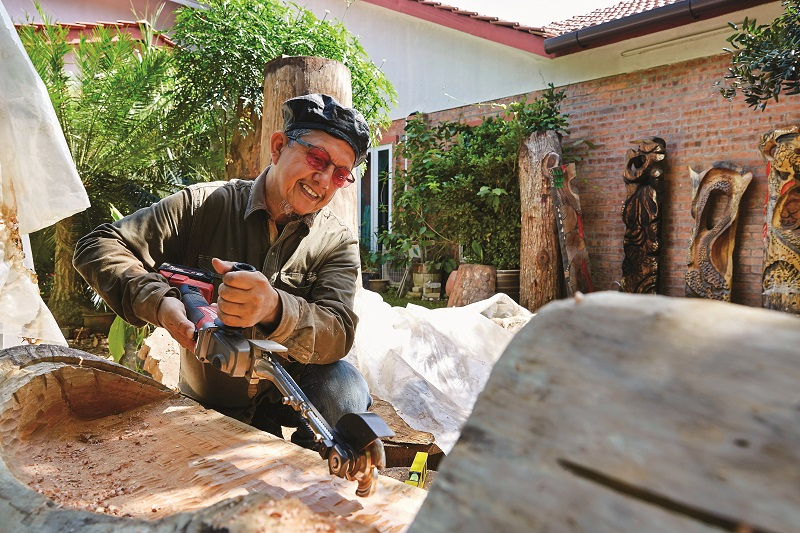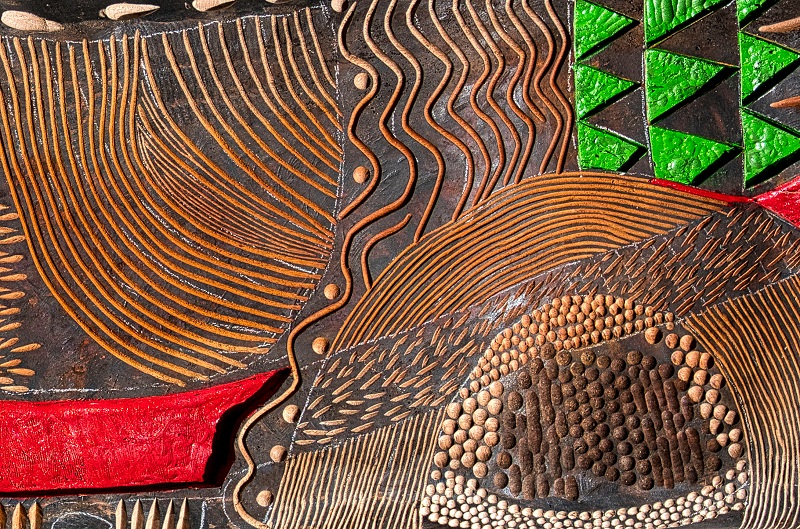
For an artist who creates works of emotions, the mechanical power tools present a double challenge (Photo: Soophye)
On his social media profile, Rafiee Ghani describes himself as a “painter-traveller”. Indeed, a scroll through his Instagram feed evokes a sense of wanderlust. As one of the country’s foremost abstract expressionist painters, his artistic career is inextricably intertwined with his travels.
Across three decades and counting, Rafiee’s body of work has largely been birthed from his sojourns, travelling being integral to his practice and process. “I always tell my wife that these are working holidays,” he quips. They are, as he typically wanders alone across both popular cities and places off the beaten track for weeks at a time, camera and sketchbook in hand.
Though now, more often than not, he takes photos then references them in drawings after, the result of an incident that has since become one of his more memorable anecdotes. The avid sketcher had attempted to draw by a river near an old bridge while in Tunisia, not realising that he had parked himself suspiciously near an army camp. This aroused military attention, and a search of his bag revealed thorough sketches of buildings, mosques and bridges, leading to even more questions on whether he was a spy.
From driving alone in Algeria and Mauritania to navigating the deep interiors of China and Afghanistan, to name but a few spots, Rafiee says he particularly enjoys seeking out hidden communities in often chaotic or controversial countries. “Chaos and joy, I’m drawn to that. I’m a happy person. I value childlikeness, where you can make fun of yourself and take nothing seriously, even though at heart you work hard. Travelling has shown me that life is often not quite what you expect. I have found the best kind of people in the harshest of countries. It gives you a broader understanding of life.”
As he details some of his adventures, one can’t help but draw a parallel to his artworks, and how the hallmark play of colours, their vivid and vibrant tones with rich and dynamic details, capture the insight of his words.
At a time when carrying oneself with an overt sense of joie de vivre seems outmoded, Rafiee admits he’s an undeniable romanticist. “I like to revisit and look back more than forward, I guess, to think back on my travels and encounters, and reminisce on a lot of the good things in my life,” shares the Shah Alam-based artist.
He describes his approach to art as akin to a folk song, where it doesn’t matter if it is joyful or sorrowful, but he always wants it to be beautiful, to capture expressions of “light and happiness”, as he imagines it.
quattro_gfx3796.jpg

New cuts, new strokes
But what happens when a painter-traveller is grounded at home? This is where our conversation picks up on a hot and humid tropical day. Here, I meet Rafiee the budding wood sculptor, who shares his journey of sawing, hacking and sanding, as we bear witness to the humbling process of an artist reinventing himself.
“I had a lot of time,” he answers when asked why a watercolour painter would choose such a hard medium — literally and figuratively — to turn to. “It has been more than a year now since the lockdowns began. In that time, I’ve also done quite a few paintings in preparation for two solo exhibitions, in Taiwan and Hong Kong. But they were cancelled.”
Rather than take some well-earned time off, Rafiee decided it was high time to reinvent himself, to learn “a new language and dance to a different tune”.
Citing masters like Picasso, César, Matisse and even Mondrian, he says all these great artists have explored or worked with different mediums, even if they are not well known for it.
“It’s about versatility. We may be stuck in a certain way of doing something. Things may have become repetitive, or look flat. When you venture into something different and come back, you may solve a problem after. Hopefully, when I go back to painting, I will improve.”
Having seen carvings and wood sculptures made using chainsawa in Canada, as well as in China and Laos, where 20 to 30 artists would sit in a sort of production line churning out intricate but traditional carvings of dragons and lions, among others, Rafiee says the idea of trying it out himself came to mind.
“I chose wood partly because of the availability of the material. Plus, I had a contact for getting logs, mahogany specifically. Personally, I think wood is more local to us. It’s warm and more natural to the tropics compared to say metal, stone or marble,” he explains.
Suffice it to say, it has been a steep learning curve, not to mention physically laborious and technical. Figuring out the right tools for the right cut has been the biggest challenge in creating the shapes and motifs he desired.
“I started with figuring out what type of wood to use — mahogany has the most uniform grain and hardness — and from there, my first few cuts were just simple grooves, lines and textures. I would get stuck and move to another piece again and again, slowly increasing my vocabulary, so to speak,” he recounts.
_s1a4833a_1.jpg

From chainsaws to chisels and hand grinders, the creative process could not be further from the eloquence of paintbrushes. For an artist who creates works of emotions, the mechanical power tools present a double challenge.
“If you try to be detailed with these tools, the result may come out overly sharp, rough or repetitive instead. I have had to balance it out through trial and error, a lot of experiments with a mixture of techniques, hand tools and machines. And sometimes, it may look good on one side, but I turn it around and it looks bad on the other. So, I have to work on it again,” he laughs.
Working up to six or seven hours every day, starting at 9am with a cup of coffee in hand, the artist has about 10 to 11 works steadily on their way to completion. The entirety of the series is based on his paintings and drawings, “So, you’ll see motifs and images like waves, lines and the wind. They are about oceans and forests and landscapes. It’s still very much my style. I’m trying to translate what I’ve done from canvas into 3D sculpture form, to create a dialogue and continuation,” says Rafiee.
During a visit by close friend and rival Jalaini Abu Hassan, Jai — as he’s known by most — said he was appalled by and yet envied the raw, messy awkwardness of starting anew, adding that Rafiee’s honest efforts bring out a sense of deep vitality as a result.
Confronting his limitations has nonetheless been daunting, he confesses. “It’s like dancing with my hands tied. Plus, I’m approaching 60 years of age now, so this has been a physical and emotional workout. But I’m motivated, and I’m happy. Tired, yes, sometimes frustrated, but I’m learning new things and getting new ideas and achieving them.”
There have certainly been a few personal lessons in the process. Patience, to start with. “I had to remind myself to go slow, to take my time and enjoy it. Normally, I want to get to the finish line quickly, especially when there is already a result in mind. But I had to be slow and even philosophical with this. People say sculptors like Michelangelo would look at the raw material and already see the form in it. But for me, even one straight line takes time to figure out. Some may take half an hour, I might take two days. But I’ll get there, one step at a time,” he reflects.
Rafiee says there is also no undoing the decisions one makes when it comes to sculpting, so adaptability is important. “You have to face your mistakes. When I come back to my work in the morning, everything I did yesterday is there, and I have to face them. Even if I question why I did it this or that way, I can’t undo it. I just have to work around it.”
redriver_gfx3760det.jpeg

The art of persistence
Both lessons lead back to a mantra Rafiee has echoed several times — keep at it and you’ll get there somehow. Looking back on his career, he says the only thing that has set him apart is the will to keep going and keep doing.
“I have failed a lot. Sometimes you don’t sell anything, and I’ve gone through that, where my exhibitions were considered a failure. I tried figurative works for two years to challenge myself. It wasn’t very successful, but I tried … I don’t think there’s a period where I stopped making art from the moment I graduated. The art making process is always on my mind. I think that’s what brought me here.”
He definitely doesn’t think it was talent that did it. Born in 1962 in Kulim, Kedah, Rafiee wanted to be a pilot, influenced by his father, a geologist who travelled often and would send postcards home with pictures of airplanes. “It was always a focus on science-based subjects because of that. None in my family were particularly artistic,” he recalls.
But an anomalous postcard depicting Van Gogh with a pipe sparked an interest in doodling, which he did around the house until his father set up a space in the garage for him to draw. Still, it was only when he embarked on his first travel adventure to Europe that his life would change course.
“I remember walking along a street with some art galleries in the Netherlands. They were already closed, but I was just looking at the artworks in the windows, and I spotted a work by Indonesian painter Srihadi Soedarsono. I thought, ‘Wow, an Indonesian painter can be displayed here!’ I really admired his work, and immediately went out to buy some crayons, sketchpads and watercolours, and thought I would try to paint like him,” Rafiee remembers.
He then joined an open studio class in The Hague, where he learnt printmaking and painting, which cemented his decision to pursue art when he returned home, eventually landing at Institut Teknologi Mara (now known as UiTM).
Like most veteran artists, Rafiee’s career has seen highs and lows. The early years were defined by a sense of “I’ll do what I want” carefreeness, buoyed by the success of his first two solo shows in 1993 and 1994, which sold out.
However, early attempts to venture abroad did not fare well. “It was pre-9/11. I went to Mexico and New York. I did a two-man show in San Francisco with Brazilian artist Romero Britto; his works sold out, I only sold two,” he laughs. The Sept 11 tragedy closed the doors on any thoughts of moving his base to the US.
Perhaps lacking a clear strategy, coupled with an unwillingness to pigeonhole himself, the middle years felt a little lost, both in terms of inspiration and the quality of his works, as he opted to focus on his travels and commercial work.
The turning point came when Rafiee showcased Homeland in 2016 with The Edge Galerie. Stirred by the floods in Kelantan and the plight of refugees in Syria, Libya and Iraq, the series depicted the emotions of someone yearning for home, expressing a longing to return to one’s roots.
It created an impact, and coincided with a renaissance in the art market for Rafiee’s works. Since then, in the last decade, his paintings have been relatively sought after in auction houses such as Sotheby’s. He has also developed a following in Taiwan, among others.
Those who collect his art appreciate the spontaneity yet mastery of his visual expression. The strong colours and joyful tone are also distinctive, and ultimately, the works are evergreen due to the timeless nature of his themes.
What does the artist think of what he has accomplished? “Creatively, I am satisfied. I have done what I wanted and people have accepted it. The only thing I wish we could have more of is better government support in pushing Malaysian artists out there, as well as greater appreciation for our arts and heritage, our culture,” says Rafiee.
Meanwhile, he hopes to exhibit this series of sculptures, in part to set an example for the younger generation of local artists. “I always say to them that good work — original ideas and strong technique — will prevail. Even if you’re not popular, keep pushing the goalpost, keep going, keep doing more, eventually people will notice.
“I get asked what my inspiration is, where do I find it … I don’t really have any, but I have discipline. I go to my studio with my cup of coffee. Sometimes, I don’t drink a sip until four hours later. You just go in and you work, that’s how I derive my inspirations,” he reiterates, observing that younger artists seem to be lacking in the habit to constantly create, sketch or use their hands.
Displaying his innate drive to keep pushing the boundaries, Rafiee says he is not done with putting new ideas on the canvas in abstract painting, nor is he content to dust off sculpture art after this.
“I can’t wait to travel again. I want to visit my father in Indonesia. Then, I think I want to go back to China again. What else? I’m still in sculpture fever, and having spoken to many sculptors, I’m told the ultimate is to do marble. It is delicate and difficult. I’m mulling it over. One day, I may embark on it. And of course, it has to be big.”
This article first appeared on Aug 23, 2021 in The Edge Malaysia.


